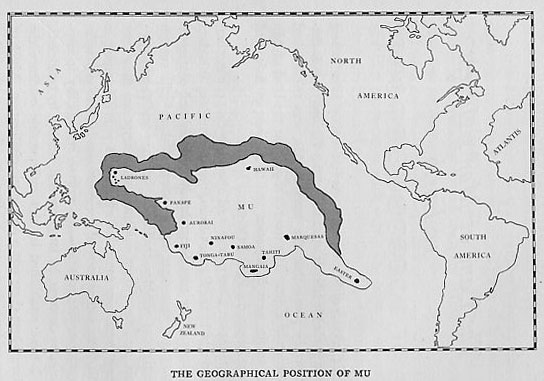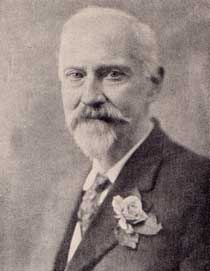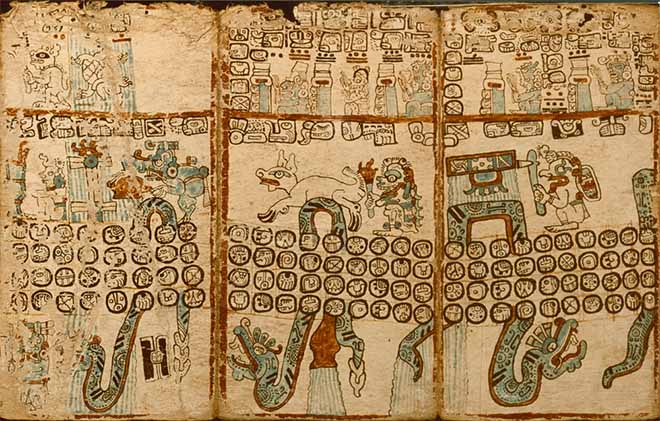The Lost Continent of Mu Legend
Perfect Lucubrations ?

Mu, like Atlantis and Lemuria, is a mythical continent of the Pacific Ocean that would have sunked in the aftermath of a great natural disaster some 12,000 years ago. Presumably located between Hawaii and the Fiji Islands, Mu would have been a vast tropical oasis hailing an advanced civilization and a fauna of large mammals like mammoths and behemoths. James Churchward, an English archaeologist and writer, took interest in the disappearance of Mu for nearly 10 years and traveled the world to pick up the pieces of this mystery to write his famous book: The lost continent of Mu.
Mu, the cradle of humanity

A long time ago, the Hawaiian archipelago would have formed with Easter Island and many other nearby islands a single super-continent, Mu. It was on Mu that the first men appeared almost 200,000 years ago and founded the mother civilization there. Inhabited by more than 60 million people, the mainland of Mu would have covered an area of 8,000 km in longitude and nearly 5,000 km in latitude. Divided into ten different tribes and ruled by the Sun Empire, Mu would have given birth to the first biblical stories (then copied by Moses) as the myth of the creation of the Earth in 7 days and that of the Garden of Eden. Thus, many legends, documents, inscriptions and symbols discovered at the four corners of the planet mention this mystic ancient land that is Mu. The story of the Lost Motherland can be retraced in the tales of Greek philosophers but also in Maya glyphs and inscriptions found in the Yucatan, on Indian tablets and in Egyptian hieroglyphs.
According to Churchward, a monumental cataclysm due to relentless earthquakes and volcanic eruptions would have caused landslides and precipitated much of Mu to the bottom of the Pacific. Only a few islets and mountain ranges would remain immersed over the sea and form the current archipelagos. Estimates speak of about one million survivors.

The Naacal Tablets, a nonsense story?
While staying in India for a humanitarian cause, Churchward would have discovered in the library of an ancient Buddhist monastery some very old texts mentioning several thousand clay tablets written in the dialect of the Naga, an Indian people of half-human half-snake beings. Intrigued by his discovery, Churchward was soon to learn from monks that Naga was the language of the Naacals, a population originating in Mu and considered in these regions as the Lost Motherland.
At the time of Mu's destruction, survivors of the cataclysm would have landed on the eastern coast of Asia. Many scholars from the lost continent would have settled in Asian temples and produced no less than 10,000 tablets telling the story of Mu. The Naacals would migrate further west and found the oldest civilizations of Mesopotamia and ancient Egypt. Churchward, who claims to have spent seven full years in a Buddhist monastery decoding the tablets, claims that they describe in detail Mu's creation, religion, civilizations and the disaster of its disappearance.
The Mayan scriptures

But even before James Churchward undertook extensive research, Charles-Étienne Brasseur (a French abbot) had translated and interpreted ancient Mayan writings found on the Yucatan Peninsula in which he believed he detected references to a lost continent, Mu. Known as Codex Troano (Madrid Codex), or in its full version as Codex Cortesianus, this manuscript was then reinterpreted by an amateur photographer, Auguste Le Plongeon, who, like Brasseur, draws out a vague description of Mu and events leading to the annihilation of the supercontinent.
Perfect lucubrations
The existence of the Mu super-continent, however, is disputed by a very large number of historians who conclude to perfect rant on the basis that James Churchward is the only one to have seen the supposed Naacal Tablets and that the translations of the Mayan codices were made from the Landa alphabet (meant to allow the deciphering of Maya texts) which does not allow reliable interpretation. Is Mu a historical reality at the origin of humanity or a simple work of fiction?









































































































































































































































































































































